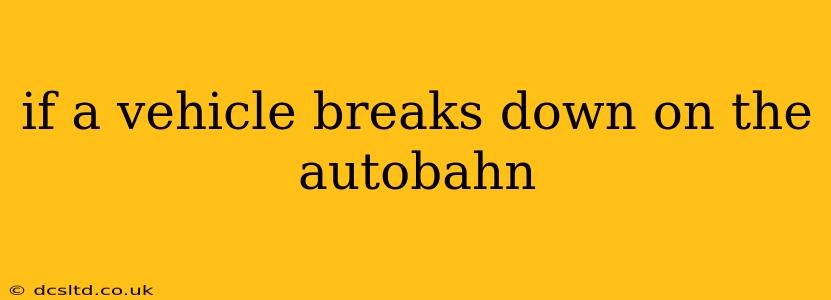The Autobahn, Germany's famed network of high-speed motorways, offers a thrilling driving experience. However, a breakdown on this fast-paced roadway can be a serious situation. Understanding what to do if your vehicle breaks down on the Autobahn is crucial for your safety and the safety of others. This guide will cover everything you need to know, from immediate actions to long-term considerations.
What to Do Immediately if Your Car Breaks Down on the Autobahn?
The first priority is to get yourself and your passengers to safety. The Autobahn isn't designed for roadside stops; high speeds and limited shoulder space make it incredibly dangerous.
-
Activate your hazard lights: This is the most important initial step. Brightly flashing hazard lights alert other drivers to your presence.
-
Pull over as far right as possible: Even if this means driving a short distance with a malfunction, prioritize getting off the main traffic lanes. Aim for the emergency lane or hard shoulder, but be aware of the limited space.
-
Turn on your warning triangle: This is legally mandated in many European countries, including Germany. Place the triangle at a safe distance (at least 100 meters) behind your vehicle, clearly warning oncoming traffic. Ensure it’s visible in both directions.
-
Get out of the vehicle and away from traffic: Once safely parked, exit the vehicle on the passenger side if possible and move to a position away from the traffic flow, beyond the guardrail if one exists.
-
Assess the situation: Check if you or your passengers are injured. If so, call emergency services immediately.
What if I'm Injured After Breaking Down on the Autobahn?
If anyone is injured in a breakdown on the Autobahn, immediately call emergency services: 112. This is the European emergency number and will connect you to the appropriate authorities. Explain your location as clearly as possible; providing kilometer markers is extremely helpful. Stay put and await assistance.
How Do I Call for Roadside Assistance on the Autobahn?
If you have roadside assistance coverage (check your insurance policy!), contact your provider immediately. They will guide you through the process, potentially dispatching a recovery vehicle. Have your policy number and vehicle information ready. If you don't have roadside assistance, consider contacting the ADAC (Allgemeiner Deutscher Automobil-Club), Germany’s largest automobile club, for assistance.
What Should I Do if My Car is Unmovable on the Autobahn?
If your vehicle is impossible to move safely, remain in the vehicle with your seatbelts fastened. The risk of being struck by another vehicle while attempting to move it in a high-speed area is too great. Call for assistance immediately – safety is paramount.
What Documents Should I Carry While Driving on the Autobahn?
Having essential documents readily available is crucial in case of a breakdown. These include:
- Driver's license: Ensure it's valid and up-to-date.
- Vehicle registration: This proves ownership of the car.
- Insurance documents: Important for roadside assistance claims.
- Passport or national ID: For identification purposes.
- Emergency contact information: Have the numbers of family or friends readily available.
What are the legal requirements in case of a breakdown on the Autobahn?
German law mandates that you take the necessary precautions to protect yourself and other drivers. Failure to do so could result in fines. This includes, but is not limited to, placing a warning triangle and activating your hazard lights.
How can I prevent a breakdown on the Autobahn?
Preventive maintenance is key. Regular vehicle checks, ensuring sufficient fuel, and checking tire pressure and tread depth before a long journey can significantly reduce the risk of a breakdown.
By following these steps and being prepared, you can significantly reduce the risks associated with a vehicle breakdown on the Autobahn and ensure your safety and the safety of others. Remember, prevention is always better than cure.
